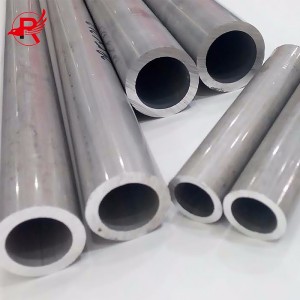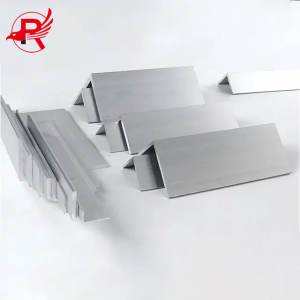Добавувач од Кина 5052 7075 Алуминиумска цевка 60mm Тркалезна алуминиумска цевка
Детали за производот

Еве некои клучни информации за алуминиумските цевки:
Материјал: Алуминиумските цевки се изработени од алуминиум, обично со додадени легирачки елементи за подобрување на својствата како што се цврстината и отпорноста на корозија. Вообичаените серии од легури на алуминиум за цевки вклучуваат 6xxx, 5xxx и 3xxx.
Димензии: Алуминиумските цевки се достапни во различни големини и димензии, вклучувајќи надворешен дијаметар (OD), внатрешен дијаметар (ID) и дебелина на ѕидот. Овие димензии обично се мерат во милиметри или инчи.
Толеранција: За да се обезбеди димензионална точност и конзистентност, алуминиумските цевки мора да ги исполнуваат специфичните барања за толеранција.
Површинска обработка: Алуминиумските цевки обично имаат мазна површина. Тие можат да се остават нетретирани или да се подложат на површински третмани како што се полирање или анодизирање за подобрување на естетиката или отпорноста на корозија.
Механички својства: Механичките својства на алуминиумските цевки зависат од видот на легурата и термичката обработка. Вообичаените механички својства вклучуваат цврстина на истегнување, цврстина на истегнување, издолжување и тврдост. Соодветни својства може да се изберат врз основа на специфичните барања на апликацијата.
Хемиски состав: Хемискиот состав на алуминиумските цевки е специфициран според индустриските стандарди или барањата на клиентите. Примарната компонента е алуминиум, со дополнителни легирачки елементи како што се бакар, магнезиум, манган или цинк.
Отпорност на корозија: Алуминиумските цевки се познати по нивната одлична отпорност на корозија. Природниот оксиден слој на површината на алуминиумот ефикасно спречува оксидација и корозија. Понатаму, одредени легирачки елементи можат дополнително да ја зголемат отпорноста на корозија на цевките во различни средини.
Методи на поврзување: Алуминиумските цевки може да се поврзат со различни методи, вклучувајќи заварување, лемење или механичко прицврстување. Избраниот метод на поврзување зависи од фактори како што се дијаметарот на цевката, барањата за примена и видот на употребената легура.
Ве молиме имајте предвид дека за детални технички информации за специфични алуминиумски цевки, погледнете ги релевантните индустриски стандарди или спецификациите на добавувачот, бидејќи техничките параметри може да варираат во зависност од примената и видот на употребената легура.
СПЕЦИФИКАЦИИ ЗА АЛУМИНИУМСКИ ЦЕВКИ
| Алуминиумска цевка/цевка | ||
| Стандарден | ASTM, ASME, EN, JIS, DIN, GB | |
| Спецификација за тркалезни цевки | OD | 3-300 мм, или прилагодено |
| WT | 0,3-60 мм, или прилагодено | |
| Должина | 1-12м, или прилагодено | |
| Спецификација за квадратна цевка | ГОЛЕМИНА | 7X7mm-150X150 mm, или по нарачка |
| WT | 1-40мм, или прилагодено | |
| Должина | 1-12м, или прилагодено | |
| Материјална класа | Серија 1000: 1050, 1060, 1070, 1080, 1100, 1435, итн. Серија 2000: 2011, 2014, 2017, 2024, итн. Серија 3000: 3002, 3003, 3104, 3204, 3030, итн. Серија 5000: 5005, 5025, 5040, 5056, 5083, итн. Серија 6000: 6101, 6003, 6061, 6063, 6020, 6201, 6262, 6082, итн. Серија 7000: 7003, 7005, 7050, 7075, итн. | |
| Површинска обработка | Завршена мелница, анодизирана, прашкасто премачкување, пескарење итн. | |
| Бои на површината | Природа, сребро, бронза, шампањ, црна, златна или по нарачка | |
| Употреба | Автоматски / врати / декорација / градежништво / ѕид за завеси | |
| Пакување | Заштитна фолија + пластична фолија или EPE + крафт хартија, или прилагодена | |




СПЕЦИФИЧНА АПЛИКАЦИЈА
Алуминиумските цевки се широко користени во различни индустрии поради нивните одлични својства. Еве некои вообичаени примени на алуминиумските цевки:
HVAC системи: Алуминиумските цевки се широко користени во HVAC (греење, вентилација и климатизација) системи поради нивната супериорна топлинска спроводливост. Тие се користат како цевки за транспорт на течности за ладење или фреони.
Водоводни системи: Алуминиумските цевки се користат во водоводните системи, особено во станбени и комерцијални згради. Нивната мала тежина, леснотијата на инсталација и отпорноста на корозија ги прават идеални за транспорт на вода, гас или отпадни води.
Автомобилска индустрија: Алуминиумските цевки се користат широко во разни автомобилски апликации, вклучувајќи системи за радијатори, системи за вшмукување, цевки за турбополнач и издувни системи. Тие помагаат во намалувањето на тежината, а воедно обезбедуваат ефикасен пренос на топлина и подобрена ефикасност на горивото.
Индустриски процеси: Алуминиумските цевки се користат во индустриски процеси што вклучуваат транспорт на течности или гасови. Тие најчесто се користат во индустрии како што се хемиска преработка, нафта и гас, фармацевтска индустрија, прехранбена и пијалачна индустрија и третман на отпадни води.
Системи за сончева енергија: Алуминиумските цевки се користат во системите за сончева топлинска енергија поради нивните високи можности за пренос на топлина. Тие најчесто се користат како цевки во сончевите системи за греење на вода.
Градежништво и архитектура: Алуминиумските цевки имаат широк спектар на примена во градежништвото и архитектурата, вклучувајќи структурни апликации, огради, завесни ѕидови и системи за обложување. Тие нудат издржливост, лесна конструкција и флексибилност во дизајнот.
Електрични апликации: Алуминиумските цевки, особено оние направени од легури со висока спроводливост, се користат во електрични апликации. Поради нивната одлична спроводливост, тие се користат за ожичување, дистрибуција на електрична енергија и собирници.
Мебел и ентериер: Алуминиумските цевки се популарни во индустријата за мебел и ентериер. Тие се користат за предмети како што се столчиња, маси, полици и шипки за завеси, бидејќи нудат модерен и стилски изглед и се лесни за прилагодување.

Пакување и испорака
При пакување и транспорт на алуминиумски цевки, важно е да се обезбеди соодветна заштита за да се спречи какво било оштетување за време на транспортот. Еве неколку упатства што треба да се земат предвид:
Материјал за пакување: Користете цврсти и издржливи материјали за пакување, како што се картонски цевки или кутии. Осигурајте се дека пакувањето е со соодветна големина за безбедно држење на алуминиумските цевки.
Подлога и перничиња: Внатре во пакувањето, ставете доволно материјал за подлога и перниче околу алуминиумските цевки, како што се меурчеста фолија или пена. Ова помага да се апсорбираат какви било удари или потреси за време на транспортот.
Обезбедете ги краевите: За да спречите лизгање или поместување на алуминиумските цевки во пакувањето, обезбедете ги со лента или капачиња на крајот. Ова додава стабилност и го минимизира ризикот од оштетување.
Означување: Јасно означете го пакувањето со информации како што се „Кршливо“, „Ракувајте внимателно“ или „Алуминиумски цевки“. Ова ќе ги потсети ракувачите да преземат потребни мерки на претпазливост за време на транспортот.
Безбедно затворање: Цврсто затворете ја амбалажата со цврста лента за пакување за да се осигурате дека ќе остане недопрена во текот на целиот процес на транспорт.
Размислете за редење и преклопување: Ако се транспортираат повеќе алуминиумски цевки заедно, размислете за нивно редење на начин што ќе го минимизира движењето и преклопувањето. Ова помага тежината да се распредели рамномерно и да се намали ризикот од оштетување.
Изберете сигурна услуга за испорака: Изберете сигурен давател на услуги за испорака кој е специјализиран за ракување со кршлива или чувствителна стока.














